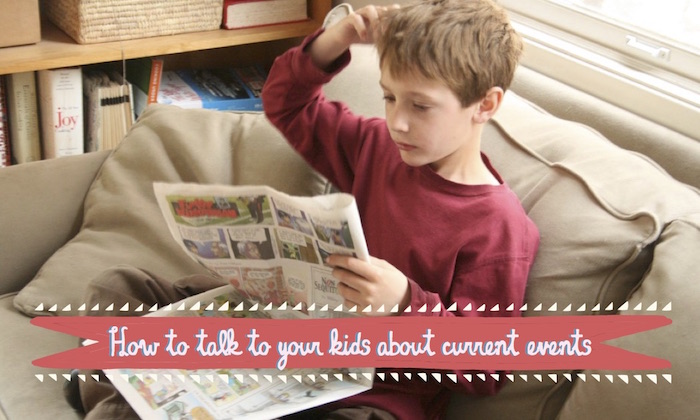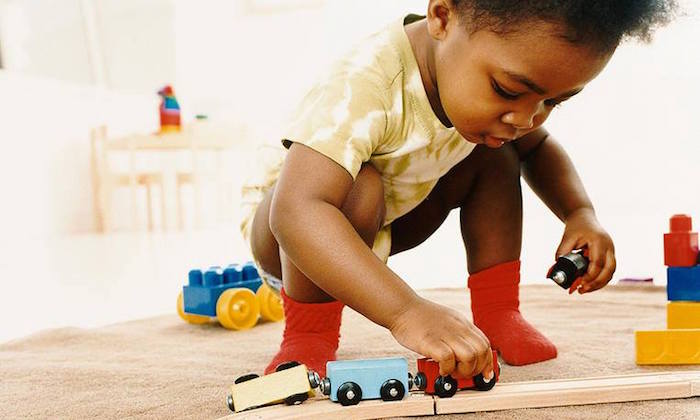
With so much technology surrounding us, it’s little wonder (and also a bit scary) that kids today are better informed than ever. Here’s how to talk to your kids about the news, courtesy of one of our teacher mamas!
My daughter is four years old. Her world revolves around playing, eating, and avoiding baths at all costs. She is very interested in anything involving silliness, sweet treats, or Sophia the First. So when she found me with my nose in The Economist the other day and asked me to read it to her, I was flabbergasted. I paused to consider the possible ramifications of reading an article to her about foreign supply chains and workers’ rights, then just decided to go for it.
I read a paragraph to her.
I looked up for her reaction.
She said, “What?!?!” in her silly voice, made a silly face, then ran off to play. Alrighty then. But it got me thinking…
I want to spend more quality time with my two little ones (my son is 20 months old). If our quality time activities can help them learn about the world and inspire them to think critically and independently, all the better right? So much can be learned from reading the news, from geography and history to statistics and vocabulary.
A major benefit of living in Singapore is that we can easily promote cultural awareness with our children through the focus on racial harmony and celebration of differences. Learning about what’s happening to other people through the news gives us the opportunity to develop empathy in our kids, which is crucial for many high level thinking skills like making inferences, writing persuasively, and comparing and contrasting points of view. But how exactly do we go about this with our kids?

Find News For Kids
There are a variety of curated new sites for kids, with differing platforms and options for use. Kids Dailies offers news for three different age groups in English, Chinese (Mandarin or Cantonese), or both. Their goal is to provide 15-20 minutes of daily reading to children who want to know more about the world, and they can even customize the content for dyslexic readers. For non-readers, they have a button to click that will to read the news aloud, highlighting each word being read. I also like that they have activities, graphics, and comics that go along with the material.

Another option is TIME Magazine’s kids’ news website. This site visually mimics adult news sites, and has many of the current headlines I see in my own news sources. It also has tabs for articles by kid reporters, world exploration, homework help, and more. It is a rich resource for news and other interesting content with an interactive family edition you can get for IOS or Android and classroom resources for teachers.
For many more news options for kids, check out the reviews by Common Sense Media and Make Use Of. They give you information about each site’s special features and minimum suggested age for usage.
Engage In Conversation
This is great fodder for dinner table conversation. Start by asking your kids what was newsworthy for them that day. News articles are generally written about new or extraordinary events, things that most people value, things that make people happy or sad, or discoveries about the world or people around us. Take turns sharing a newsworthy event from each family member’s day. Then move on to an article from a kids’ news source. Each night, family members can take turns reading an article to the group on a topic of personal interest. After listening, engage in some discussion using these questions as a guide:
- What do you think about this? Do you agree or disagree with the actions taken in this article? Why or why not?
- How do you think [the main person involved in the story] feels about this? What decisions might they make in the future about this? Why do you think that?
- Play devil’s advocate and take a stance opposite to what your family member has taken. Switch roles on the next article and encourage your son or daughter to put themselves in the shoes of someone who thinks opposite to the way they naturally think. Why might this person feel the way they do? What justifications might they have? What might change their thinking?
- Do you know anything related to this? Have you heard about this at school or from friends?
- Could you see yourself being involved in something in relation to this article? Why or how? What would you do?
Particular topics may spark ideas for future learning—take note of these. You can look up information together later on, or plan a trip to a local museum, government building, or the library to learn more. Keep it lighthearted and fun; kids may find they look forward to meals as a time when they get real and undivided attention from parents and respect for their opinions.

Deal With Bad News
When Lee Kuan Yew passed away, I felt I ought to prepare my daughter for any information she might hear at her preschool approaching his funeral. She was 3 then, and my talk with her didn’t go as well as I had hoped. Her takeaway: She often says, “You get sick and then you die, like Lee Kuan Yew.” Sigh… maybe she would have had a more balanced understanding if she was older.
Though using kids news sources will help you avoid many “bad” topics, kids are bound to become aware of many of the negative and scary news stories in the world, along with topics that are just plain difficult to discuss. It is important to help our kids face these topics rather than navigate them alone. We can teach them thinking and coping strategies for understanding the world around them. There are as many options for handling this as there are parenting styles, but here are a few guidelines:
- Tell the truth. Don’t glorify a negative event, but be forthcoming about what happened, the causes and the results. Kids will question you if they want to know more, so provide a summary then let them proceed as far as they are interested. Don’t be afraid to ask your child how they feel about the event, and why they feel that way. Also mention the positive side of a negative event. This quote by Fred Rogers is helpful for communicating this:
“When I was a boy and I would see scary things in the news, my mother would say to me, ‘Look for the helpers. You will always find people who are helping.’” This is a great way to help young ones process scary things; even in dark times, there is an element of control people can exert to help or support others in a time of need. - Avoid graphic details and exposure to media. We all know how haunting certain pieces of media coverage can be, so be careful what your kids are exposed to and how often. Media coverage of big events can be very repetitive. If watching the news with them, pause it or turn it off to discuss it in the moment in order to help them make sense of what they have seen or heard.
- Encourage questions—try not to judge. Kids are naturally curious about all kinds of things. Help them explore the various sides of social issues. For many issues, there are well made documentaries you can watch with older kids that will help you discuss an issue. For sensitive issues dealing with race, disabilities, or other minority experiences, there are numerous blogs written about firsthand experiences all over the world, along with advice for people of the majority group in treating people well and fairly. Find these and discuss them. If your son or daughter wants to help in cases of injustice, find groups on Facebook or Change.org that might help you play a role.

- Give space for expressing feelings. Kids will experience a wide range of feelings when encountering news stories. Learning how to express and cope with these feelings is part of growing up. Say, “It’s natural that these things bother you. We are here to support each other. Let’s learn more about this.” Expressing feelings in a non-judgmental environment is the first step; it can often help them feel better just to be heard. If your son or daughter is still agitated, help them think of ways to help by participating in change groups as mentioned above, or by writing letters to appropriate groups or agencies. It can be a great family activity to participate in a run/walk to support a cause, or raise funds for a worthy charity. To deal with excessive anxiety or stress in your children, seek outside assistance from therapists or read helpful articles written by therapists.
- Ensure they feel safe. Give hugs and affection, and describe the ways in which you can be proactive in terms of safety to protect yourself and loved ones. When discussing acts of violence or crime, be sure to explain the rarity of these occurrences. Still, have a plan for a fire or health emergency, and make sure your plan is posted in a place your kids can reference if they forget.Make sure they know their address and the numbers to call in an emergency (and discuss what constitutes an emergency). Find friendly neighbours your kids can run to should they need help. After these kinds of discussions, tune into their feelings and encourage them to discuss follow-up questions that arise, and try to focus on more positive news for a while.
I recently gave all of this a try with my 4-year-old. She was attentive as Kids Dailies 7 read her an article about Nelson Mandela, and she was interested in clicking on the rest of the links to see what else the website had on the topic. The level was definitely above her, but I liked the structure better than the Daily 5 option. She wanted to listen to the main news story again after exploring. I think she will be open to reading it again with me, though she wasn’t so interested in discussing it further (her typical response when something is a bit over her head).
I did not engage her with further questioning as much as I could have; I wanted her to enjoy reading the news for our first time. I am looking forward to asking her what she thinks about articles in the future, and wish you luck finding what works for your family as well, mamas!






 View All
View All





 View All
View All









 View All
View All





